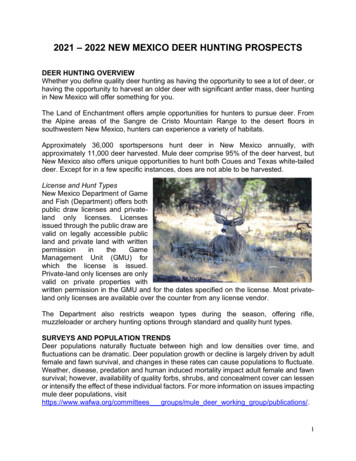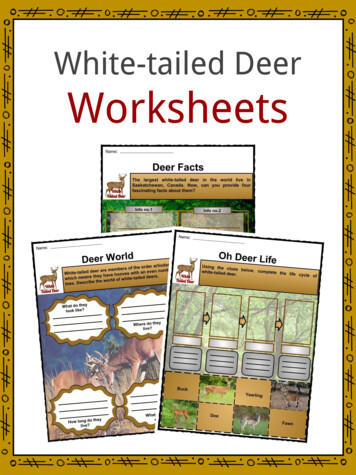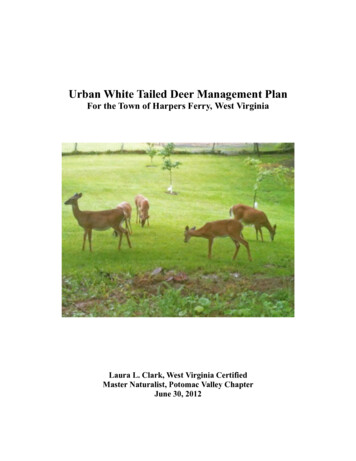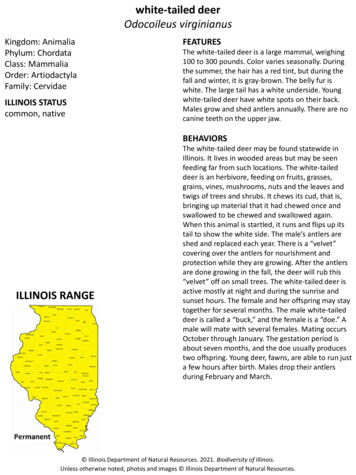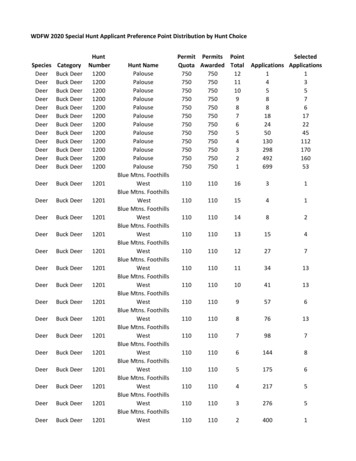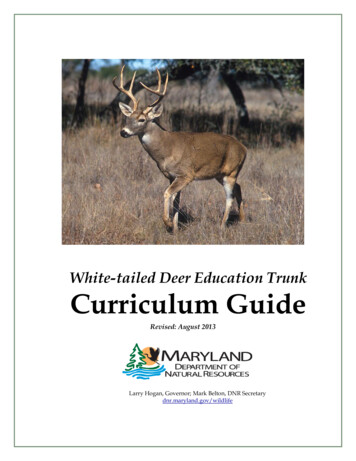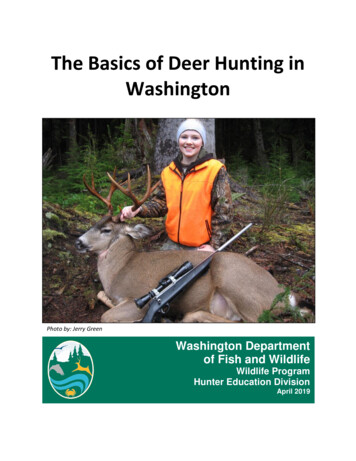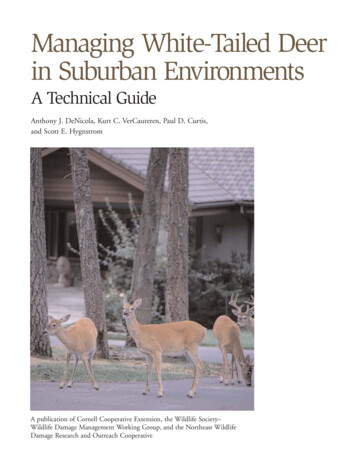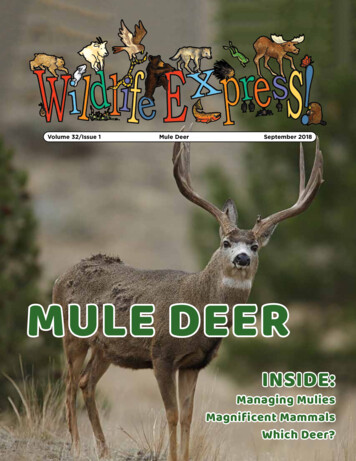
Transcription
WHITE-TAILED DEER FOODHABITS AND PREFERENCESIN THE CROSS TIMBERS ANDPRAIRIES REGION OF TEXASbyJim DillardSteve JesterJohn BaccusRandy SimpsonLin Poor
WHITE-TAILED DEER FOODHABITS AND PREFERENCESIN THE CROSS TIMBERS ANDPRAIRIES REGION OF TEXASbyJim DillardTexas Parks and Wildlife DepartmentMineral Wells, TexasSteve JesterTexas Parks and Wildlife DepartmentBrownwood, TexasJohn BaccusTexas State UniversitySan Marcos, TexasRandy SimpsonTexas State UniversitySan Marcos, TexasLin PoorTexas State UniversitySan Marcos, Texas
ACKNOWLEDGEMENTSThe results of research used in this publicationconcerning white-tailed deer food habits and preferencesin the Cross Timbers and Prairies Region of Texas wasfunded by Texas Parks and Wildlife and Federal Aid toWildlife Restoration Project W127R. Funding for thispublication was made possible by the Texas Parks andWildlife Foundation and Texas Parks and WildlifeDepartment. Field work was conducted by Lin Poor,Texas State University, as part of a Master’s Thesisproject. We wish to thank John Baccus, Randy Simpsonand other staff of Texas State University for helpingcoordinate the study and assisting with the field work.Many students from Texas State University also assistedwith collection of data and related laboratory work andgreatly contributed to the successful completion of theresearch. In addition, special thanks is extended to TexasParks and Wildlife Department wildlife biologists andwildlife technicians assigned to the Possum KingdomWildlife District for their assistance in collecting samplesfor the study and helping coordinate access to collectionsites and disposition of deer collected to charitableorganizations. Unless otherwise noted, photographs forthis publication were taken in the Cross Timbers andPrairies Region of Texas by Jim Dillard and Kevin Mote.A special thanks to Dana Price and Jason Singhurst forproviding a photograph of Hill Country Wild Mercury. Wethank Kevin Mote, Wildlife Diversity Biologist, TPWD, forhis assistance in plant identification. Elishea Smith,Wildlife Interpretive Program Graphic Designer, TPWD,provided layout and design of this technical bulletin.Most importantly, we thank the landowners and landmanagers in the Cross Timbers and Prairies Region thatallowed Texas Parks and Wildlife and Texas StateUniversity personnel access to their properties to conductthe study and collect the necessary data. Without theirgenerous contribution and support, this importantresearch could not have been done. As a result, asignificant amount of information about what white-taileddeer eat and which plants they seasonally prefer hasbeen documented and will be beneficial to otherlandowners and land managers here in the Cross Timbersand Prairies Region of Texas.
TABLE OF CONTENTSIntroduction1History1The Cross Timbers and Prairies Region3Changing Land Uses in the Cross Timbers and Prairies Region9White-tailed Deer Food Habits10Overall Use of Forage Classes12Deer Diets in the Cross Timber and Prairies Region of Texas (by season)13Conclusion26Bibliography27Appendix A: Plant List28Appendix B: Native Food Plants - Woody Plants36Forbs49Grasses61
INTRODUCTIONThe Cross Timbers and Prairies Region of Texasis a land of contrast. From the dense post oakblackjack oak woodlands of Cooke andMontague counties on the Red River to thefertile sandy fields of Comanche County andprairies of Lampasas County, it is a land likenone other in Texas. It is an area rich in historyand natural resources, woodlands and wildlifeand people, whose diverse cultural influencescontinue to shape and mold the region today.White-tailed deer provide an importantresource to landowners and land managers inthe Cross Timbers and Prairies Region of Texas.Their presence adds aesthetic as well as eco nomic value to farms and ranches throughoutthe region. The demand for lease huntingrecreation for white-tailed deer creates aneconomic incentive for landowners to manageland and habitat resources to meet the biolog ical needs of white-tailed deer. Increasingdemands for the space that white-tailed deerand their habitat occupies in the Cross Timbersand Prairies Region have created seriousmanagement challenges for landowners. Mostland in the region is privately owned;consequently, management responsibilities restalmost entirely with individual landowners.The degree of importance they place on themanagement of this species and its habitat willdetermine the quantity and quality of presentand future populations of white-tailed deer andother native wildlife species found in this vastecological region of Northcentral Texas. Thedevelopment of strategies for managing popu lations of white-tailed deer and their habitatrequires knowledge of seasonal food habitsand preferred plant species used for food.Many of these plant species also serve animportant role as cover for white-tailed deerand many other species of wildlife found inthe Cross Timbers and Prairies Region. Habitatrequires the application of proper managementtechniques by landowners to sustain, manageand conserve populations of white-tailed deerand other wildlife. This publication providesdetailed information about which plants areseasonally important in the diet of white-taileddeer in the Cross Timbers and Prairies Region.HISTORYOnly a few adventurers in North Texas hadtraveled west of the Trinity River before the1840s. In the 1850s the army established ascattering of military forts on the frontier ofTexas to protect settlers from depredatingIndians. At this time, only early military roadscrossed through this region. Early travelersfrom Louisiana, Arkansas and Oklahomacrossed the vast expanses of the BlacklandPrairies of Northcentral Texas, largelyunencumbered by features of the terrain. Onthe western horizon they encountered a dark,green ominous feature on the landscape, abarrier to travel that slowed their progress.These “timbers” of dense growths of oak trees,brush and vines occupied a rough, hilly terrainbisected by creeks, canyons and deep gullies.These early settlers found abundant game,water, wood for fuel and building and landswell suited for livestock production. They alsofound Indians whose tenacity to hold onto theirancestral lands ushered in almost 50 years ofconflict over who would ultimately inherit andhusband the Cross Timbers and Prairies Region.Although openings occurred in this timberedarea and natural prairie areas were present,much of the region was still difficult to crossthrough to the western frontiers of Texas. It isINTRODUCTION HISTORY1
believed that because of their repeated cross ings through the “timbers”, early travelers andsettlers coined the name “Cross Timbers”, aterm still used today to describe the region.Early travelers knew the location of the Eastand West Cross Timbers and used them aspoints of reference in travel. In 1772, DeMezieres (Dyksterhuis 1948) stated that fromthe Brazos River north “ one sees on the righta forest that the native appropriately call theGrand Forest Since it contains some largehills, and because of the great quantity of oaks,walnuts, and other large trees, it is a placedifficult to cross On the farther edge of thisrange, or forest, one crosses plains having plen tiful pasturage ” and in 1778 “ I crossed theColorado and Brazos, where there are anincredible number of Castilian cattle, andherds of mustangs that never leave the banksof these streams. The region from one river tothe other, is no less bountifully supplied withbuffalo, bear, deer, antelope, wild boars,partridges, and turkeys.”In 1840, Col. Stiff (Dyksterhuis 1948) uponapproaching the Cross Timbers of Texas fromthe western prairies stated, “In turning to thenortheast, something much resembling anirregular cloud is dimly seen. This is a skirt ofwoodland called the Cross Timbers Whetherthis was once a beach of a mighty lake or a seawe must leave to the geologist to determine.” OnJuly 21, 1841, Kendall (1841) stated, “We arenow fairly within the limits of the Cross Timbers The immense western prairies are bordered,for hundreds of miles on their eastern side,by a narrow belt of forest land, well known tohunters and trappers under the above name.”He stated, “The growth of timber is principallysmall gnarled, post oaks and black jacks, andin many places the traveler will find an almostimpenetrable undergrowth of briers (sic) andother thorny bushes.”Marcy (1866) stated of the Cross Timbers,“At six different points where I have passed2HISTORYthrough it, I have found it characterized by thesame peculiarities; the trees, consisting princi pally of post-oak (sic) and blackjack, standingat such intervals that wagons can with out dif ficulty pass between them in any direction. Thesoil is thin, sandy, and poorly watered.” In1854, W. B. Parker traveled with a survey partyof the United States Government to locate andsurvey lands for Indian reservations in northTexas. He noted, “The timber is a short, stunt ed oak, not growing in a continuous forest, butinterspersed with open glades, plateaus, andvistas of prairie scenery, which give a verypicturesque and pleasing variety.” On crossingthe Upper (Western) Cross Timbers west ofpresent day Gainesville in Cooke County,Parker stated, “Below, stretching as far as theeye could reach, lay the apparently inter minable forest of the Cross Timbers, like abarrier, on passing which we were to be shutout from civilization, its joys and cares, formany, many weeks.” Dyksterhuis (1948)described the Western Cross Timbers as anarea “ extending 150 miles south from thenorthern limits near the Red River, curvingwestward at the southern extremity. The MainBelt and the Fringe together, though muchinterrupted, occupy the major portion of anarea 150 miles long, varying in width fromabout 25 miles at the north to about 110 milesat the south.”Settlers came during the mid-1800s searchingfor a new land to raise families, to farm andranch and to make a better life. Legendarycattlemen like Charles Goodnight and OliverLoving came to the region to build their cattleherds and trail them to northern markets. Thelure of the land and new beginnings alsobrought changes to the Cross Timbers andPrairies Region, changes that continue toinfluence this broad zone of woodlands andprairies and its wildlife.
THE CROSS TIMBERS AND PRAIRIES REGIONThe Cross Timbers and Prairie Region encom passes approximately 26,000 square miles inNorthcentral Texas. It is bordered on the eastby the Blackland Prairie, the west by theRolling Plains and extends south and south westward to the Llano Basin and EdwardsPlateau in central Texas. It can be further sub divided into four vegetative subregions: EastCross Timbers, Fort Worth Prairie, LampasasCut Plain and West Cross Timbers. This broadvegetative region also extends northward intoOklahoma and southern Kansas. (Figure 1 Diggs et. al. 1999). Figure 1 - Image courtesy of BRIT(Botanical Research Institute of Texas)THE CROSS TIMBERS AND PRAIRIES REGION3
The soils and terrain seen today give littleevidence of the enormous forces involved inshaping the Cross Timbers and Prairies Region.Complex geologic events formed this region ofTexas. Plant and animal life that occurs heretoday is a direct result of those events and thesoils that ultimately were formed. Nearly allsurface rocks of Northcentral Texas weredeposited during the Cretaceous Period(145-65 millions years ago). Some exposed sur face formations in the western part of the WestCross Timbers subregion date from the 300 million-year-old Pennsylvanian Period. Soils ofthe East and West Cross Timbers subregionswere developed on sandy Cretaceous Wood bine and Trinity strata. In the Fort Worth Prairieand Lampasas Cut Plain subregions, shallowsoils were formed over Cretaceous limestoneparent materials. Elevations across the regionrange from 500 to 1,500 feet.Soils throughout the region are not uniform.Consequently, plant communities changedramatically within short distances resultingin different land use potential for livestockgrazing, farming, wildlife management orother uses.Although white-tailed deer occur throughoutthe ecological region as a whole, populationsvary considerably between and within the sub regions. Populations of white-tailed deer andother wildlife species are influenced by thediversity and configuration of plant communi ties that provide food and cover. Other factorssuch as fragmentation of once continuous habi tat into smaller land holdings, competition for4food and cover with livestock, conversion ofwoodland habitat to improved pastures or otheragricultural enterprises, urban and rural devel opments and lack of proper wildlife and habi tat management also influence the ability of theland to support populations of deer and otherwildlife species.The East Cross TimbersJim DillardA basic understanding of the location andphysical description of these vegetative sub regions of the Cross Timbers and PrairiesRegion is important to individuals interested orinvolved in management of wildlife and wildlifehabitat. The transition between these subre gions is often subtle or unrecognizable to thecasual observer. However, distinct changes intopography, soil types and vegetation serve asvisual signposts to their delineation.The East Cross Timbers subregion is a narrowstrip of timbered country extending fromeastern Cooke County on the Red River southto western Hill County and includes portions ofGrayson, Denton, Dallas, Tarrant, Johnson andMcLennan counties. Early travelers called thisregion the Monte Grande (Grand Forest) andlater the Lower Timbers. Its location was wellknown and served as a landmark reference fortravelers. Today, few large tracts of undisturbedwoodlands remain in the East Cross Timberssubregion which is perhaps one of the mostfragmented vegetative regions in Texas. Soilsare slightly acidic, sandy or sandy loam andproduce woodlands dominated by post oak,blackjack oak, cedar elm, hickory, osageorange, eastern red cedar, mesquite, bumelia,hawthorn, greenbriar and a variety of otherbrush and grass species.Many woodland areas in this region have beencleared for tame-grass pastures, croplands,horse and cattle ranches and urban and ruraldevelopments, including portions of the citiesof Denton, Dallas, Fort Worth, Arlington andother expanding urban and rural fringe commu nities. Considerable human population expan sion throughout this region will continue toTHE CROSS TIMBERS AND PRAIRIES REGION
impact wildlife habitat resources in the future.White-tailed deer management in the East CrossTimbers subregion will prove to be challengingto landowners and will require innovativeapproaches to management of the habitatresources found there.central Texas that includes Fort Worth andseveral surrounding towns. These landscapescale changes will have long lasting conse quences for the future of wildlife and habitatresources in this subregion.Lampasas Cut PlainThe Fort Worth Prairie subregion is locatedbetween the East and West Cross Timberssubregions, extending from extreme easternMontague County and Cooke County on thenorth, southward to northern McLennan Countynear Waco. Portions of Denton, Wise, Tarrant,Parker, Johnson, Hood and Hill counties occurwithin the subregion. Terrain of the mostlytreeless vegetative region, located north of theBrazos River, is characterized by gently slopingflat surface features with thin soil over hardlayers of resistant limestone. Underlying layersof limestone slope eastward with the exposedends of younger layers forming escarpments or“cuestas” that produce the scenic topographytypical for the area.Vast tallgrass native prairies once covered thisregion. Most grasslands have been degradedand remain only as remnants where shallowsoils prevented cultivation. Considerablefarming and livestock grazing operations wereinitiated by early settlers in areas of sufficientsoil depth in this subregion. Extensive areas arestill used for livestock grazing, but climax plantcommunities have been altered. Urban sprawland developments have rapidly expanded intothis subregion as the human populationcontinues to increase in this area of North-Jim DillardJim DillardFort Worth PrairieThe Lampasas Cut Plain subregion lies southand southwest of the East and West CrossTimbers and Fort Worth Prairie subregion,extending to the upper reaches of the EdwardsPlateau in Burnet and Williamson counties.Other counties found in the subregion includeparts of Johnson, Somervell, Erath, Hamilton,Comanche, Brown, Mills, Coryell, Bosque, Hill,McLennan, Bell and Lampasas counties. Most ofthis region is underlain by various limestoneformations. The Lampasas Cut Plain subregionis more rugged than the Fort Worth Prairiesubregion, being bisected by numerous lowbuttes and mesas formed by erosion during itsgeologic formation. There are extensive regionsof grasslands and valleys with higher, narrow,often wooded mesa-like divides. Soils at thesurface, consequently, support the growth ofplants adapted to higher alkalinity, such as liveoak and juniper. Historic records indicate muchof this region existed as a grassland or openlive oak savannah that supported herds ofbison and other herbivores dependent on thetall grasses that dominated the region.The rich loam soils now support agriculturalcroplands in many areas that produce cotton,corn, oats, wheat, sorghum, milo and othercrops. Much of the land in this region is alsoused for livestock ranching for cattle, sheepTHE CROSS TIMBERS AND PRAIRIES REGION5
After the introduction of domestic livestock,farming operations and control of wildfires,the landscape of much of the Lampasas CutPlain subregion changed. Land use practicesassociated with these and other venturescreated a landscape that experienced theinvasion and domination in some areas byproblematic brush species such as mesquite,Ashe juniper and other native woody species.Overgrazing by livestock and elimination ofnaturally occurring fire also reduced nativegrass cover and allowed the invasion of otherless desirable annual grasses and forbs. Thischange in plant life on the landscape, however,has increased habitat for a number of wildlifespecies and can be viewed as a positive resultof historical land use in the Lampasas Cut Plainsubregion.Management of habitat for white-tailed deerand other wildlife species in the Lampasas CutPlain subregion can be financially rewardingto landowners and land managers.White-tailed deer numbers exist at or substan tially above habitat potential (the ability ofnative habitat to support them without sustain ing long-term degradation of plant communitiesor loss of plant species) in much of this sub region. Farm and ranch size is relatively large,making accomplishment of land managementstrategies for white-tailed deer and habitat bothproductive and feasible.West Cross TimbersJim Dillardand goats. Habitat for white-tailed deer, RioGrande turkey, bobwhite quail, mourningdoves, fox squirrels, rabbits and a variety ofnongame wildlife species is found here.The West Cross Timbers subregion, locatedimmediately west of the Fort Worth Prairiesubregion and north of the Lampasas Cut Plainsubregion, extends from the Red River inMontague and Cooke counties south andsouthwestward to the Lampasas Cut Plainsubregion and west to the Rolling PlainsRegion. This zone also includes portions ofArcher, Clay, Wise, Young, Throckmorton, Jack,Tarrant, Parker, Palo Pinto, Stephens, Callahan,Eastland, Erath, Hood, Somervell, Johnson,Hamilton, Comanche, Mills and Browncounties. This region was called the UpperTimbers by early travelers due to its higherelevation.This subregion has a complex geologic history,resulting in a variety of soil types, terrainfeatures and vegetative plant communities. Theterrain in most of this subregion is very hilly,with sandstone and limestone escarpments,steep slopes, and irregular surface features.Watersheds of the Red, Colorado, Trinity andBrazos Rivers cross the region from northwestto southeast. Exposed sandstone rocks andboulders dominate landscape features in manyareas. Sandy loam soils are productive for agri cultural crops such as peanuts, small grains,fruit trees, sorghum, pecans and truck crops.In other areas, limestone surface formationsand shallow clay soils support grasslands andvegetative plant communities adapted to higheralkalinity.Features of the Fort Worth Prairie subregionextend into the West Cross Timbers subregion6THE CROSS TIMBERS AND PRAIRIES REGION
along the eastern boundary, forming irregularecotones of diverse tree and brush speciescommon to both zones.Extensive open grasslands and brushy range lands also occur in the West Cross Timbers sub region. In the western counties, where the aver age size of land tracts increases, cattle ranchingis the predominant land use. Winter agriculturalforage crops such as wheat and oats are com monly planted.Post oak-blackjack oak woodlands characterizemuch of the West Cross Timbers subregion.Other associated woody species include shinoak, Spanish oak, live oak, Texas ash, mesquite,osage orange, Ashe juniper, eastern red cedar,cedar elm, skunkbush sumac, elbowbush,lotebush, tasajillo, rough-leafed dogwood,flame-leaf sumac, hawthorn and hackberry.Much of the subregion contains habitat thatsupports populations of white-tailed deer andmany other wildlife species. Many of thesepopulations exist at or above the habitat poten tial of the land. Leasing land for deer hunting isan important economic enterprise of the sub region. Fragmentation of wildlife habitat is alsorapidly increasing in the eastern counties of theWest Cross Timbers subregion where largerland holdings are being subdivided and sold assmall home building sites, farms and ranchettes.Climate and RainfallRainfall in the Cross Timbers and PrairiesRegion ranges from 36 inches per year in theEastern Cross Timbers subregion to 24 inchesper year in the western portion of the WesternCross Timbers subregion, with most of theForth Worth Prairie and West Cross Timberssubregions averaging between 28 and 32 inch es. During summer months, temperatures mayexceed 100º F for several days and extensivedrought periods are not uncommon. Winter lowtemperature extremes occasionally approach0º F, however, only a few days each winterdrop below 20º F. Mean annual temperature is65º F. Seasonal flooding along major water courses may occur during spring and earlysummer from storms and weather systems thatmove through the region. Snowfall duringwinter is uncommon and usually of limitedintensity and duration. Hail, high winds,tornadoes and thunderstorms occur seasonally,affecting only small portions of the region atany given time. However, these events mayresult in localized damage to wildlife habitatand resident populations of wildlife.The growing season ranges from 218 days inJack County in the north to 260 days inWilliamson County in the south, with mostcounties in the Cross Timbers and PrairiesRegion averaging between these two extremes.Rainfall patterns and temperatures throughoutthe year are a significant factor influencingwhite-tailed deer habitat in the Cross Timbersand Prairies Region. Peak rainfall occursnormally in May and September. Belowaverage rainfall during late summer and winterreduces the growth of forb, grass and brushspecies important to white-tailed deer. Mastproduction from a wide variety of plants usedby white-tailed deer depends on timely rainfallpatterns throughout the year. During periods ofdrought, acorn production on oak species ishighly variable. Growth of cool season forbsand grasses also depends on timely rainfallduring the early fall and winter months.Agricultural crops planted for livestock grazingor crop production provide forage for whitetailed deer in the Cross Timbers and PrairiesRegion and have become important seasonalfoods. In many areas, white-tailed deer distri bution is directly influenced by the presenceor absence of these planted agricultural crops.During wet cycles, marginal habitat for whitetailed deer may become occupied if adequateagricultural crops are present within their homerange. When rainfall is inadequate or extremetemperatures occur, crops become unproduc tive and white-tailed deer populations andhabitat cannot be sustained. These artificiallyTHE CROSS TIMBERS AND PRAIRIES REGION7
high white-tailed deer populations ultimatelywill decline.Annual rainfall also directly influences rangeconditions and, thus, grazing pressure bydomestic livestock. Unless landowners andmanagers adjust stocking rates or grazingintensity on rangelands during droughts, whitetailed deer populations suffer. Competitionbetween livestock and white-tailed deer foravailable forage will occur as food and coverresources diminish. During periods of drought,increased consumption of browse by livestockmay reduce the availability of importantseasonal forage for white-tailed deer.Extremes in temperature and rainfall patternsaffect white-tailed deer habitat and cannot becontrolled by land managers, only anticipated.They will occur in the Cross Timbers andPrairies Region of Texas as they have for eons.Land managers should consider the likelihoodthat these events will occur and make appro priate decisions during the initial planningstages of white-tailed deer habitat and popu lation management strategies.TPWD stock photoThe impoundment of water for domestic live stock has produced one of the most importantchanges to the landscape of the Cross Timbersand Prairies Region and has increased thepotential of the land to sustain populations ofwhite-tailed deer and other wildlife species.The countless number of lakes, small pondsand stock tanks constructed as water sourcesfor domestic livestock in the Cross Timbers andPrairies Region also serve as important seasonalsources of water for white-tailed deer andother wildlife species. However, the availabilityof water depends on runoff of surface waterfrom heavy rainfall events. With the exceptionof the major rivers that cross the region, moststreams in the Cross Timbers and PrairiesRegion are intermittent and do not providereliable surface water. During years of belowaverage rainfall, many water sources becomedry, directly affecting white-tailed deer andother wildlife species.The countless number of lakes, small ponds and stock tanks constructed as water sources for domesticlivestock in the Cross Timbers and Prairies Region also serve as important seasonal sources of water forwhite-tailed deer and other wildlife species.8THE CROSS TIMBERS AND PRAIRIES REGION
CHANGING LAND USES IN THE CROSS TIMBERS AND PRAIRIES REGIONWhite-tailed deer habitat in the Cross Timbersand Prairies Region today continually changesin response to natural environmental forces andhuman influences that mold and shape plantcommunities on the landscape. These changeshave occurred primarily due to the cumulativeeffects of overgrazing by livestock, eliminationand control of naturally occurring fire in theenvironment, and changes in land use by man.The influence of farming and livestock ranch ing in this region for food and fiber productionhas had long-term influences on habitat forwhite-tailed deer and other wildlife speciesfound in the Cross Timbers and Prairies Region.Large herds of free ranging livestock had begunto influence the plant communities of the CrossTimbers and Prairies Region by the end of the19th Century. The introduction of fences on thelandscape in the 1880s further compoundedthe problem by allowing increased stockingrates and grazing duration. As a result, nativegrasslands began to diminish and the invasionof brush and non-native plants accelerated.It has been estimated that by the 1920s and1930s, 26 million acres of forested and prairieland in the Cross Timbers and Prairies Regionwere converted into fields, primarily for theproduction of cotton, corn and wheat. Of thatfigure, approximately 8 million acres had beendeveloped from formerly forested land(Francaviglia, 2000). Many areas in the CrossTimbers and Prairies Region that once hadnative prairies, savannahs or open rangelandshave since been invaded by woody species,annual forbs and non-native grasses. Many ofthese species have become dominant on rangesites, making recovery or restoration of historicgrasslands or savannahs difficult for landmanagers.The increase in density and distribution ofwoody plants such as post oak, blackjack oak,live oak, Spanish oak, mesquite, Ashe juniperand many other native tree and brush specieshas created improved habitat for white-taileddeer and other wildlife species in some areas.White-tailed deer have benefited from thesechanges in the distribution and patterns of treeand brush plant communities that provide theirhabitat needs for food and cover. Developmentof reliable water sources to accommodate live stock ranching operations also has had a posi tive influence on the land to help support andsustain populations of white-tailed deer andmany other wildlife species.Most woody tree and brush species found inthe Cross Timbers and Prairies Region, with theexception of live oak, juniper species and a fewothers, are deciduous. White-tailed deer habitatduring the winter months often becomes limitedin its capacity to provide food and cover.Seasonal availability of food and forage may bethe most critical limiting factor for white-taileddeer in the Cross Timbers and Prairies Region.Economic influences have played an importantrole in changing land uses in this region tomeet the public demands and markets for food,fiber, minerals, agricultural crops, livestock, oiland gas production. Development of land forurban expansion has also increased dramaticallyduring the last 50 years. This change in landuse will continue to be a significant influenceon habitat for white-tailed deer and otherwildlife species in the future. Beautiful woodedhillsides and tree-covered valleys are not onlygood habitat for white-tailed deer and otherwildlife species, they are also attractive homebuilding sites for people. Land clearing forimproved pastures,
funded by Texas Parks and Wildlife and Federal Aid to Wildlife Restoration Project W127R. Funding for this publication was made possible by the Texas Parks and Wildlife Foundation and Texas Parks and Wildlife Department. Field work was conducted by Lin Poor, Texas State University, as part of a Master's Thesis project.
